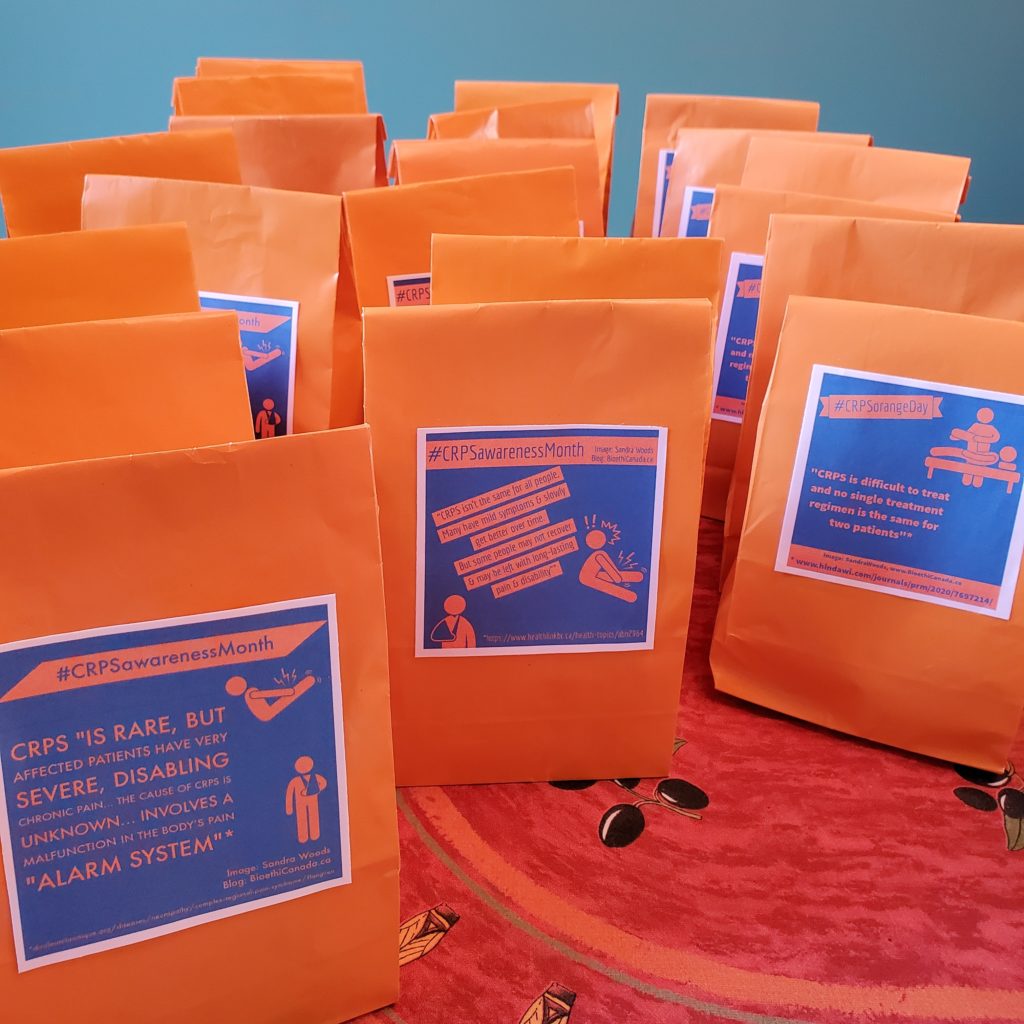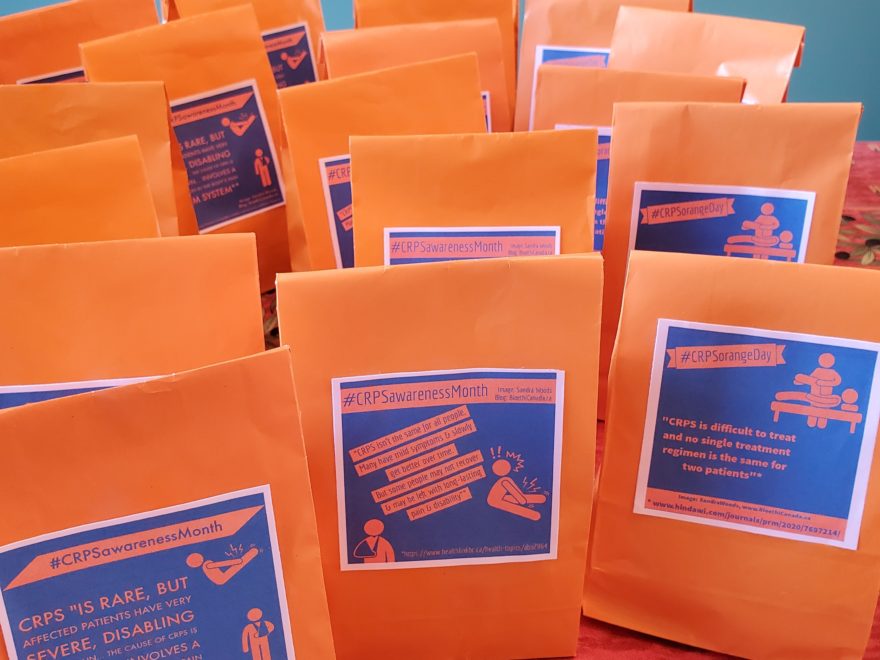This year, because of the COVID-19 pandemic, there were fewer trick-or-treaters than usual in my area at Halloween. Although I’d expected that there might be less activity than in previous years, I hadn’t wanted to run out of candies and disappoint any kids.
We normally have about a hundred visitors for Halloween, and hand out 3 or four miniature chocolate bars to each along with a tiny bag of chips. Those would be packets of crisps to my friends in the British Isles, who call French fries ‘chips’ as in fish’n’chips.
With only fifty or so trick-or-treaters this time around, I was left with quite a lot of extra candy and chips. Food banks and other charities wouldn’t take any of it because I’d opened the boxes, and I certainly didn’t want to end up eating all of it! As I went to sleep Halloween night, I was wondering what to do with all this candy.
At some point during the night, as usual, my pain woke me up. While trying to use mindful meditation techniques to get back to sleep, I had a brilliant idea. I could use the extra treats as a facet of my awareness campaign for CRPS, because November is CRPS Awareness Month, for a rare condition called Complex Regional Pain Syndrome.
The disease awareness colour of this medical condition is orange, and I remembered that I had some glossy orange paper bags in a closet somewhere. The bags were left over from a baby shower game that I’d set up a few years back, and were still in their original packaging. The next morning, I slipped on same latex gloves and pulled these bags out of a closet, and set to work.
I’d already created a set of blue and orange social media images for CRPS Awareness Month, so I printed some of these in a smaller format and glued them onto the orange bags. While wearing a mask and disposable latex gloves, of course.
Each image included some information about this rare disease from either a medical or scientific journal or a government website. Reliable sources of information for healthcare professionals, to whom I’d be delivering these bags.
Still masked and gloved, I then added to each of the bags a few miniature candy bars and a small package of chips. In several bags I also included a flyer with more detailed information about CRPS, as a kind of bonus.
By the time I was done, I’d prepared almost fifty bright orange bags with blue disease awareness messages. Over the course of the next two weeks, I delivered batches of these ‘bright bags’ to different clinics and pharmacies in my area; not for their patients, but for their employees.

It’s important for nurses, pharmacists, and physiotherapists to be familiar with this condition so that they’ll be able to recognize it in their patients. The symptoms of CRPS are often so strange and varied that they don’t seem to be related to each other. Someone who has the disease may not even realize that their symptoms are connected, and may avoid going to see their doctor at first.
Instead, a person might instead ask a trusted pharmacist, nurse, or physical therapist about just one or two of their symptoms:
Complex regional pain syndrome (CRPS) usually develops after an injury, surgery, stroke or heart attack.
The key symptom of CRPS is continuous, intense pain that is out of proportion to the severity of the injury.
The pain gets worse over time.
CRPS most often affects one of the arms, legs, hands, or feet, and the pain often spreads throughout the entire affected arm or leg.
Other signs and symptoms may include:
. sensitivity to touch or cold
. swelling of the painful area
. changes in skin temperature, color, and/or texture
. joint stiffness and swelling
. muscle weakness and/or muscle spasms
Symptoms may change over time and vary from person to person. In some people, signs and symptoms of go away on their own.
In others, symptoms can persist for months to years.” (1)
This is why my CRPS awareness activities are usually geared towards healthcare professionals, to increase the likelihood of patients receiving a rapid diagnosis and treatment for this little-known condition. If this disease isn’t diagnosed and treated quickly it can ‘settle in’ and become entrenched, leading to a permanent and disabling condition:
CRPS can happen to anyone at any age, but women in their 40s to 60s are more likely to get it.
CRPS isn’t the same for all people.
Many have mild symptoms and slowly get better over time.
But some people may not recover and may be left with long-lasting pain and disability.” (2)
That’s what happened to me; my diagnosis was delayed by three months and I now live with some disabling effects of CRPS. My hope is to prevent this from happening to others, by bringing CRPS to the attention of healthcare professionals who might never have heard of it:
Even though some doctors are now diagnosing it sooner, many patients aren’t seen soon enough during the six month window when there is an 80-90% success rate.
Others are diagnosed and do not receive the proper treatment.
Why?
In medical school, CRPS is not taught.
By better educating the medical community on this rare disease, we hope that every newly diagnosed patient will be able to have successful treatment.” (3)
My ‘bright bags’ of CRPS information were very well-received, with one pharmacy even asking me to bring in more of them – for their team members who were off that day. I might do something similar again for CRPS Awareness Month next year, using something more original than leftover Halloween treats!
As always, thanks so much for stopping by. Feel free to share this post, or any others from this blog. It’s 100% non-commercial and unfunded; there’s just me. Have as good a day as possible, and take a few moments just for yourself; to savour a coffee or tea, look out the window, read a book, call a friend… something that makes you happy!
References
(1) Genetic and Rare Diseases Information Center (GARD). Diseases: Complex regional pain syndrome. Website. Undated. Online:
https://rarediseases.info.nih.gov/diseases/4647/complex-regional-pain-syndrome
(2) Healthwise, Inc., for HealthLink BC. Complex Regional Pain Syndrome. Website. Updated 20 Nov 2019. Online:
https://www.healthlinkbc.ca/health-topics/abn2964
(3) PARC. Recognition of RSD/CRPS. Promoting Awareness of RSD and CRPS in Canada (PARC). Online. Accessed 09 Nov 2020:
https://www.rsdcanada.org/parc/english/parc/aboutus.html

